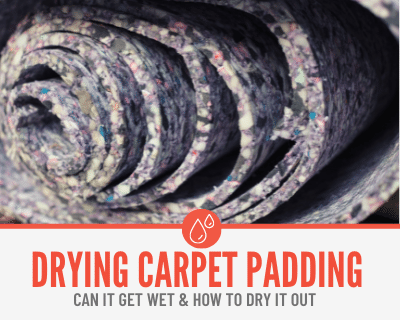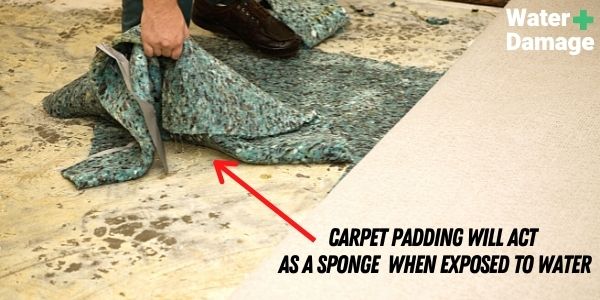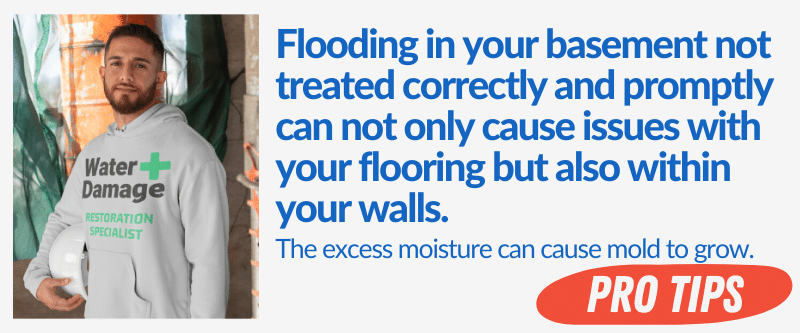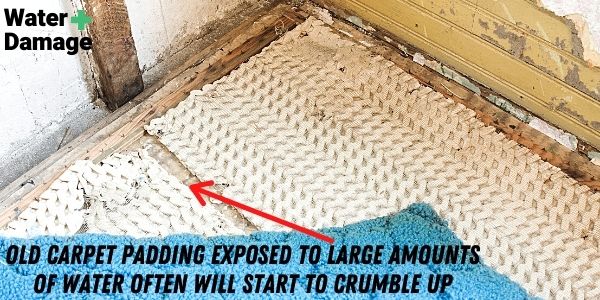Wet Carpet? You suspect the padding underneath your carpet is now wet too?
In this guide you will learn:
- How to tell if your Carpet Padding is wet,
- Is it possible to Dry your Carpet Padding,
- How to dry different kinds of Carpet Padding,
- How to remove Mildew smell from wet carpet padding

How to tell if your Carpet Padding is Wet
Often, you will start with the type of spill or situation on your hands. A glass of water spilled on the floor can be treated differently than a basement that floods (see below for basement flooding).
In any event, assuming you feel the water has moved through the carpet to the padding, then you need to peel back your carpet with a pair of pliers.
Even though your carpet is wet you want to make sure there is no water in the padding.
Once the section of padding is uncovered (or your carpet removed in a larger flood) you can use your foot or a towel to see how much water your carpet padding has absorbed.
If you step on the padding with your foot and the padding emits excessive water, then you need to follow our steps to dry your carpet padding.
You can also do the same with a towel and push down on the padding to see if there is an excess of water build-up.
Carpet Got Wet?
Call 844-488-0570 for a Risk Free estimate from a Licensed Water Damage Restoration Specialist in your area.
We Can Help Dry out Your Carpet & Carpet Padding
Can Carpet Padding get wet? Is it Waterproof?
It is most likely that your carpet padding is not waterproof.
The padding under your carpet will act like a sponge and when your carpet is wet the padding underneath will soak in the water.
Since there is little air circulation underneath your carpet the water or flooding will often cause big issues with your padding.
There are many kinds of carpet padding (see below in this article) but it would also be wise to note what kind of padding is under your carpet and if needed direct specific questions about that padding to a professional.
Can you dry out carpet padding?
You can dry out your carpet padding and the rug does not necessarily need to be completely removed.
Peeling back sections of the carpet to treat the wet areas of your padding is where you should begin. If needed with a large flood, you may still need to remove your entire carpet to treat the entire area of padding.
How To Dry Wet Carpet Padding
Kinds of carpet padding
Padding underneath your carpet serves all types of purposes from protecting your carpet’s life span, providing cushioning while walking, helping control heating and cooling temperatures, and even helping soundproof the room!
Certain kinds of carpet padding do claim to provide extra moisture barriers but historically carpet padding will hold water and often acts like a sponge when exposed to water.
Both fiber padding and foam padding retain water and can cause moisture issues when your carpet gets wet.
Fiber padding – Heavy and dense. Examples are polyester and felt underneath your carpet.
Foam padding – Soft, light, and comfortable padding underneath your carpet.
Moisture barrier – An extra layer of protection to help guard against water and moisture.
For all the paddings listed above, in the event of a flood or a spill, your main goal is to eliminate the moisture in the carpet padding. The main way to do this is by creating an airflow and allowing the air to help dry the carpet padding.
The carpet padding will take longer to dry than the carpet so a degree of patience is required. Foam padding is lighter and softer than a denser fiber padding and thus foam may take even longer than the fiber.

Step by step guide to Dry out Your Carpet Padding
Below are some universal steps to drying your carpet padding if it is wet.
Note you can add disinfectant to the damp or wet areas you are treating as an option if you are dealing with the build-up of mold and mildew or if you are dealing with dirty sewage or flood water (also reference the section on mold below).
** Always use proper safety precautions when potentially touching chemicals and bacteria with your bare hands with the proper use of gloves, masks, and safety glasses.
Materials needed:
- Gloves, safety glasses, mask
- Towels
- Fans
- Wet vac / Shop-vac
- Baking soda, disinfectants
- Carpet pliers
How to Do it:
- Remove or peel back the carpet so you treat the affected / wet area of your carpet padding.
- Soak up the water by using a shop vac, wet vac, or a towel.
- Use fans on the wet spots to create more airflow.
- If possible, open windows and allow the sun to hit the padding and help with drying.
- If possible, set your air conditioner at a lower temperature to help with drying.
- Apply baking soda in modest amounts to help eliminate the moisture.
- Repeat steps if necessary.
For Drying out Carpets/Padding with Fans Read our Guide: How to Dry Wet Carpets with Fan
Wet Carpet padding in Basement
If your basement has flooded, you need to make sure that you are not dealing with sewage water. Sewage water will have harmful bacteria in it that can get deep into the pores and fibres of the carpet padding and cause excess build up.
This can cause health issues and it is not sanitary. Contact a professional if the affected area is too large or if you feel the situation is not sanitary.

Steps you can take to dry out carpet padding your basement:
- Remove the carpet by peeling back portions to treat the affected areas.
- Use a wet vac or shop vac to suck up as much water as possible.
- Create as much airflow as possible by using fans and/or lowering your air conditioner temperature.
- Apply disinfectant to areas to kill mold and mildews bacteria.
- Consider the use of a dehumidifier to help absorb the moisture in this situation.
- Repeat if necessary and be patient with this process.
Drying Carpet Padding After Large Flood
After a large flood it will be necessary to remove the entire carpet. You need to create as much air flow and circulation as possible so removing the carpet will allow for maximum air flow.
The air flow will prevent the build-up of bacteria. Eliminating moisture is key so mold does not have the chance to grow and spread.
If left untreated wet padding underneath the rug create a ripe environment for the growth of many kinds of bacteria.Flood water may also pose a risk if the water is dirty, and this can create unsanitary conditions.
If this is the case, then you must use a disinfectant on the padding to help kill bacteria. Remember to use gloves, glasses, and a mask when touching unsanitary water for your health protection.

Mold in Carpet Padding & Removing Mildew Smell
Mold will grow in about 24 to 48 hours if not treated promptly. Mold, when left unchecked, can pose serious health risks so make sure you take precaution and treat the situation promptly.
Mold can worsen lung and asthmatic conditions, cause wheezing, coughing, watery eyes, and sore throats.
Once the carpet is removed you can follow these steps to help combat mold and mildew smell under the carpet
- Use the wet vac to eliminate as much water as possible.
- Sprinkle a light amount of baking soda over the carpet padding. Baking soda will help eliminate moisture.
- Use a fan, setting on low power, to provide air circulation over wet spots and baking soda.
- Apply disinfectant to effected areas. Make sure you use rubber gloves, a mask and safety glasses when handling chemicals.
- Keep in mind that the more air circulation you can create the better. Open windows and sunshine are among some of the best ways to help combat the moisture build up and the smell.
How to Dry Car Carpet Padding
If the inside of your car and the padding is wet due to a spill, leak, or rain fall similar issues can arise as they would with your carpet padding. The carpet padding will retain moisture and this moisture will allow for the growth of mold and mildew. You can have a rotten smell or stench in this situation.
Similar steps maybe taken to dry out wet car padding. The smaller size of the car compounds some of the issues with airflow but a few steps dry your padding and eliminate moisture will often do the trick.
- Using a towel, pat dry all the wet areas in all corners of the affected area in your car.
- If necessary, use the shop vac or wet vac to eliminate any standing water.
- Apply baking soda to help draw out the moisture.
- Use a fan to create the air flow needed to help eliminate the moisture in that area.
- Consider the use of a disinfectant to combat the growth of bacteria.
- Repeat steps, as necessary.
When To Call a Professional?
If the area is too much for you to treat on your own, then feel free to call a professional. Often times water damage to the floor can also cause issues with your walls.
If you feel that the water damage has covered a large area or has been allowed to sit for a while untreated it might be best to inquire with a professional.
If the situation is a flood or sewage water and unsanitary you may contact a professional because of the health risks and considerations.
I would always inquire as to what type of carpet padding you have underneath your carpet before beginning (reference earlier in article) and direct specific questions about that padding to the professional.
If you have flooding that has saturated not only your carpet padding but also your floor (water has gotten under the padding and caused damage) then it would be advisable to contact a professional.
Treating your wet carpet would also fall under this category but if your carpet, padding, and floor are all damaged a professional would have the tools and ability to handle this situation in the most appropriate manner.
We have Water Damage Restoration Technicians that can help Dry out your Carpet & Carpet padding.
Available in 95% of USA ,For Disasters of all Sizes
